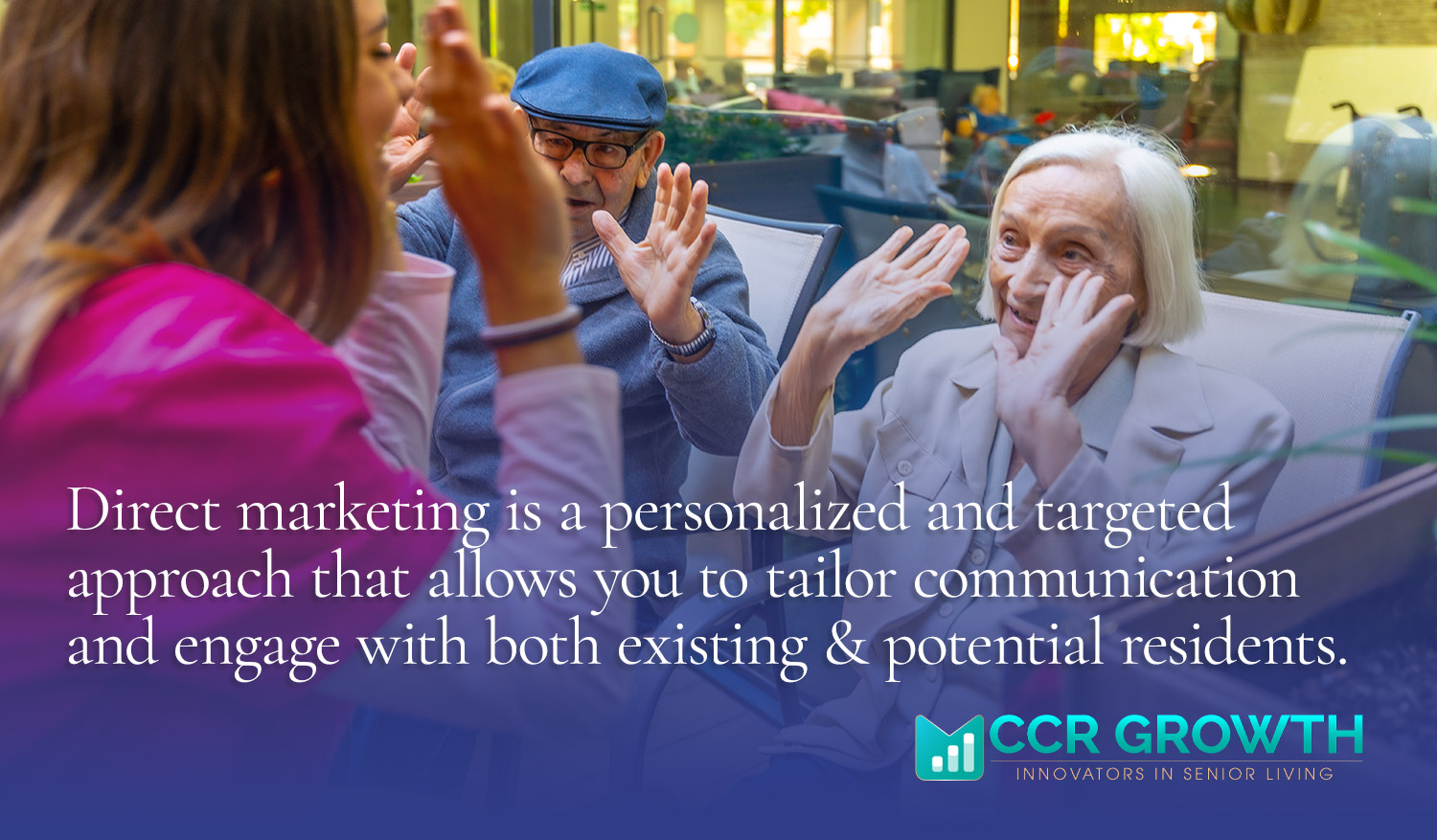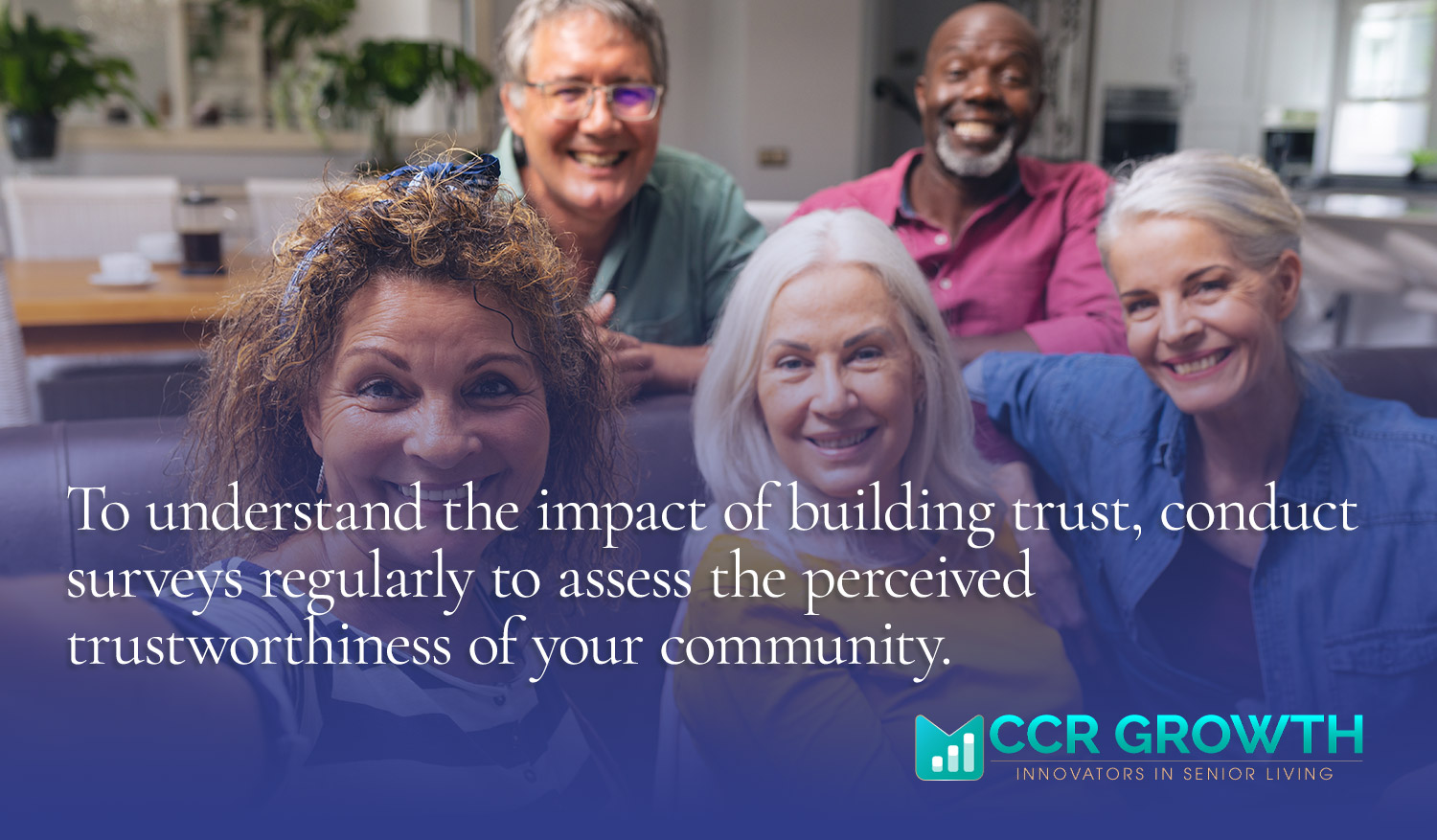
CCR Growth
Build Trust Through Direct Senior Living Marketing
When it comes to cultivating a relationship of trust, direct marketing is a stand-out tool not only for fostering meaningful connections with your residents, but also as a way to build rapport with potential residents. In this comprehensive guide, we’ll delve into the profound impact of direct marketing on trust-building, thoroughly explore what it entails, and outline various ways to implement it.
These marketing and communication strategies aim to empower Senior Living Providers to connect more meaningfully with their community members, ensuring a transformative approach to marketing in the senior living sector.

Outline
Published on
13/03/2024
Unlocking the Essence of Direct Marketing

Defining Direct Marketing
Direct marketing isn’t just a communication strategy; it’s a personalized and targeted approach that allows you to engage with individuals or groups of potential and existing residents. This personalized communication approach is distinctly different from mass marketing, which tends to cast a broad net.
For instance, if you want to share news about a local community with potential residents, traditional marketing might involve a mass flier drop or using local media for a broader reach, making it less targeted. However, direct marketing involves identifying and reaching your specific audience, such as using personalized emails or targeted social media campaigns. This approach ensures a more intimate connection, crucial in the senior living sector where trust is paramount. The benefits extend to cost-effectiveness, as direct marketing focuses solely on your target audience, maximizing impact while minimizing expenses.
Target Audience vs. Existing Customers
It’s important to distinguish between your target audiences when it comes to direct marketing. Imagine a scenario where the target audience comprises adult children researching senior living options for their parents. Knowing this will ensure your message is tailored to address the concerns and preferences of this demographic. For example, you might aim to highlight the safety features and community engagement by providing detailed information about the healthcare facilities and recreational activities. This approach ensures your message is more resonant and impactful communication.
On the other hand, the type of messages you craft for the residents of a community require a vastly different approach. As these are existing customers, they would benefit from learning about community events and improvements, the latest exclusive promotions for on-site services. Overall the aim of this type of direct marketing is to foster a sense of belonging and loyalty.
Strategies for Trust-Building Through Direct Marketing

1. Personalized Communication
Imagine a direct email campaign that goes beyond merely addressing the recipient by name. Picture a scenario where the entire message is tailored to the recipient’s specific interests and needs. For instance, if an individual has shown interest in fitness programs, the communication could highlight the community’s state-of-the-art fitness center and personalized wellness plans. This level of personalization goes beyond surface details, delving into the intricacies of individual preferences.
How do you do this? By analyzing past interactions, such as website visits or responses to previous marketing materials, Senior Living Providers can refine their approach and ensure that every piece of direct communication resonates effectively.
A report by McKinsey & Company called Next in Personalization 2021, shows that adopting personalization in marketing efforts can drive a company’s growth trajectory by 40%. Moreover, the findings showed that just over 70% of respondents expect brands to personalize communication to them, and if that doesn’t happen, 76% say they find this frustrating. Interestingly, when asked to define what personalization is, respondents described it as being made to feel special.
2. Educational Content
Educational content serves as a cornerstone of trust-building in senior living. One way to do this is through a monthly newsletter that not only informs but educates a specific target audience on topics like navigating senior living decisions, understanding healthcare options, and tips for a smooth transition. This positions the community as a trusted source of valuable information, elevating the brand beyond a mere service provider.
A study by Clemens Rob published in PLOS ONE in 2021 explains that informative content, which it refers to as content marketing, can “strengthen customers’ brand trust and induce favorable brand attitudes, and increase customers’ perceived value of a brand, leading to more favorable responses to the brand and its communications, and thus helping the focal organization reach its strategic business objectives.”
However, it is important to track and analyze engagement metrics on your content to understand which topics resonate most with specific audiences. This allows Senior Living Providers to continually refine their educational content strategy, ensuring that it remains relevant and impactful.
3. Transparent Communication
Here’s where trust your brand has earned through its direct marketing efforts can be maintained. Transparent communication is not just a strategy; it’s a commitment to openness and honesty. Picture hosting virtual town hall meetings where community leaders openly discuss upcoming changes, address concerns, and invite residents to share their thoughts. This level of transparency builds trust and a sense of community involvement, where residents feel not just informed but genuinely heard.
A Harvard Business Review study on the efficacy of surveys showed that customers who were asked to answer just one survey were 200% more likely to have become more invested in the brand, were more loyal and were overall more profitable than those who were not surveyed.
Consider running regular surveys with residents to gauge their satisfaction levels and using the feedback to inform future communications. These surveys serve as invaluable tools for understanding the pulse of the community. By collecting and analyzing resident feedback, Senior Living Providers can proactively address concerns and continuously enhance their communication strategies.
4. Community Stories and Testimonials
There’s no doubt about it: authentic stories serve as powerful testimonials, showcasing the genuine impact of choosing a senior living community. Visualize a video series featuring real residents sharing their personal stories and positive experiences within the community. It’s not just about promoting features; it’s about telling real stories that resonate emotionally with the target audience.
The best way to gauge the success of a testimonial campaign like this is to track the conversion rates of leads exposed to testimonial content compared to other marketing materials. By measuring the effectiveness of testimonial content, Senior Living Providers can gain insights into what resonates most with their audience. This data-driven approach enables continual refinement of storytelling strategies to create a more compelling and impactful narrative.
5. Targeted Promotions
Targeted promotions go beyond generic marketing campaigns, ensuring that every message reaches its intended audience with precision. Envision implementing targeted promotions for specific segments of your resident base. For instance, offering a limited-time discount on wellness programs for those who have shown interest in health-related content. This targeted approach not only increases the likelihood of conversion but also demonstrates a deep understanding of individual needs.
To see if this is working, try analyzing the response rates of these kinds of promotions to refine future marketing strategies. By closely monitoring the performance of targeted promotions, Senior Living Providers can identify patterns and preferences within their audience. This data-driven approach empowers providers to continually optimize their promotional strategies, ensuring maximum impact with minimal resources.
Wrap-Up

Understanding the impact of direct marketing on both residents and potential residents is crucial for Senior Living Providers. It’s not just about acquiring new customers; it’s about creating an environment where your current residents feel valued and prospective residents trust your community. In this phase, Senior Living Providers need to employ a holistic approach to impact evaluation.
Conducting regular surveys to assess the perceived trustworthiness of the community and using the insights to iterate on direct marketing strategies. Surveys become a tool for gauging the community’s reputation and the effectiveness of direct marketing efforts. By collecting and analyzing survey data, Senior Living Providers can identify areas for improvement and implement targeted strategies to enhance trust-building initiatives.
Ready to explore how we can help you transform your senior living community sales success? Get in touch with our leading senior living marketing conversion team today!
Subscribe to our newsletter
Sharpen your expertise and stay ahead of senior living industry trends—subscribe to CCR Growth’s newsletter for exclusive insights and updates.
Proud Members of:

Redefining Senior Living Marketing, Sales, and Operations
CONTACT ADDRESS
8710 Carmel Valley Road, Carmel, CA 93923
GENERAL INQUIRIES
info@ccrgrowth.com
(831) 273-3628
SOCIAL MEDIA





